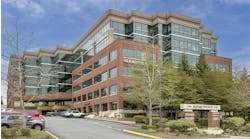Washington & Atlanta — Rumblings that green buildings may not, despite all of their other salubrious qualities, actually save energy will be put to rest by efforts from the U.S. Green Building Council and the American Society of Heating, Refrigerating & Air-Conditioning Engineers.
At its June mid-year meeting in Louisville, Ky., ASHRAE introduced a prototype of a building energy label that aims to change the “face” of building energy use.
A prototype label for the ASHRAE Headquarters in Atlanta was unveiled. The Building Energy Quotient program, which will be known as Building EQ, will include both asset and operational ratings for all building types, except residential. ASHRAE is working with major real estate developers to implement the label prototype this fall with a widespread launch of the full program in 2010. For more information, visit http://buildingEQ.com.
“As the United States looks to reduce its energy use, information is the critical first step in making the necessary choices and changes,” Bill Harrison, ASHRAE president, said. “With labeling mandatory in Europe and disclosure of a building's energy performance becoming required by several states, now is the time to introduce a label that can serve as a model for mandatory programs. ASHRAE's introduction of its prototype labeling program couldn't be better-timed.”
As part of LEED v3, the latest version of the U.S. Green Building Council's program for green building design, construction, operations and maintenance, buildings seeking LEED certification will begin submitting operational performance data on a recurring basis as a precondition to certification.
“Today there is all too often a disconnect, or performance gap, between the energy modeling done during the design phase and what actually happens during daily operation after the building is constructed,” said Scot Horst, senior vice president of LEED, U.S. Green Building Council. “We're convinced that ongoing monitoring and reporting of data is the single best way to drive higher building performance because it will bring to light external issues such as occupant behavior or unanticipated building usage patterns, all key factors that influence performance.”
USGBC will be able to use the performance information collected to inform future versions of LEED.
Ron Jarnagin, who chairs the ASHRAE committee developing the building label, noted that the market, with its move toward placing a premium on energy-efficient properties, would benefit from a labeling program.
“When potential building tenants and owners have information on the properties they are interested in, they can understand the full cost of their investment and place a value on the energy efficiency of a building,” he said. “ASHRAE's label will help building owners differentiate their product in a technically sound manner while providing tenants with the tools they need to select energy-efficient spaces.”
The ASHRAE labeling program differs from existing labeling programs in that it focuses solely on energy use. Under the ASHRAE program, new buildings will be eligible to receive an asset rating. An operation rating will be available once the building has at least one year of data on the actual energy use of buildings. Existing buildings would be eligible to receive both an asset and operational rating.
“Building performance will guide LEED's evolution,” said Brendan Owens, USGBC's vice president of LEED technical development. “This data will show us what strategies work — and which don't — so we can evolve the credits and prerequisites informed by lessons learned.”
“It will also help us to educate building owners on how users of the building can impact its energy use and water consumption, to be sure the building is operating as it was designed to,” added Horst. “Similar to the sticker on a new car that says the car will get 30 miles to the gallon — the car is calibrated to perform but it's also reliant on the driver's habits.” Projects can comply with the performance requirement in one of three ways:
-
The building is recertified on a two-year cycle using LEED for Existing Buildings: Operations and Maintenance.
-
The building provides energy and water usage data on an on-going basis annually.
-
The building owner signs a release that authorizes USGBC to access the building's energy and water usage data directly from the building's utility provider.
The requirement creates a data stream on LEED-certified building performance that can be used by owners and operators to optimize their building performance and promote the establishment of energy efficiency goals over the life of the building.
“LEED was created to transform the way we build and operate buildings with a goal of reducing the impacts of the built environment,” added Horst. “The LEED design and construction certifications recognize one piece of a building's lifecycle, but it's the day-to-day running of the building that has dramatic impact on its performance. We know that buildings can be a huge part of the solution for reducing greenhouse gas emissions and fossil fuel dependence and USGBC sees this as one more step forward in accomplishing its goals for addressing climate change.”

